The Lenovo ThinkStation P900 Workstation Review: Design 101
by Ian Cutress on May 6, 2015 7:00 AM ESTSystem Benchmarks
Power Consumption
Power consumption was tested on the system at the wall. This method of power reading allows us to compare the power management of the UEFI and the board to supply components with power under load, and includes typical PSU losses due to efficiency. These are the real world values that consumers may expect from a typical system (minus the monitor).
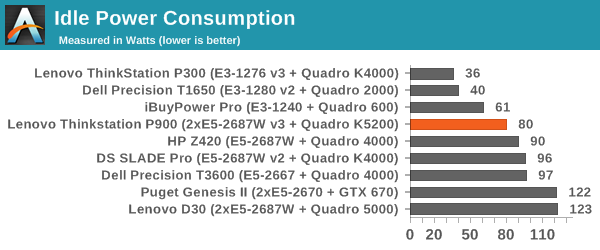

Idle power consumption, compared to some of the other big systems, is actually rather good due to the 1300 W Platinum power supply. Load consumption for a 2P system was also lower than expected, giving 231W for both CPUs between load and idle power results.
Windows 7 POST Time
Different motherboards have different POST sequences before an operating system is initialized. A lot of this is dependent on the board itself, and POST boot time is determined by the controllers on board (and the sequence of how those extras are organized). As part of our testing, we look at the POST Boot Time using a stopwatch. This is the time from pressing the ON button on the computer to when Windows 7 starts loading. (We discount Windows loading as it is highly variable given Windows specific features.)

As with most 2P systems, POST time is rather long. There is no management IC on this system, but DDR4 training for each socket easily accounts for 20-30 seconds of the POST time.
Rightmark Audio Analyzer 6.2.5
Rightmark:AA indicates how well the sound system is built and isolated from electrical interference (either internally or externally). For this test we connect the Line Out to the Line In using a short six inch 3.5mm to 3.5mm high-quality jack, turn the OS speaker volume to 100%, and run the Rightmark default test suite at 192 kHz, 24-bit. The OS is tuned to 192 kHz/24-bit input and output, and the Line-In volume is adjusted until we have the best RMAA value in the mini-pretest. We look specifically at the Dynamic Range of the audio codec used on board, as well as the Total Harmonic Distortion + Noise.
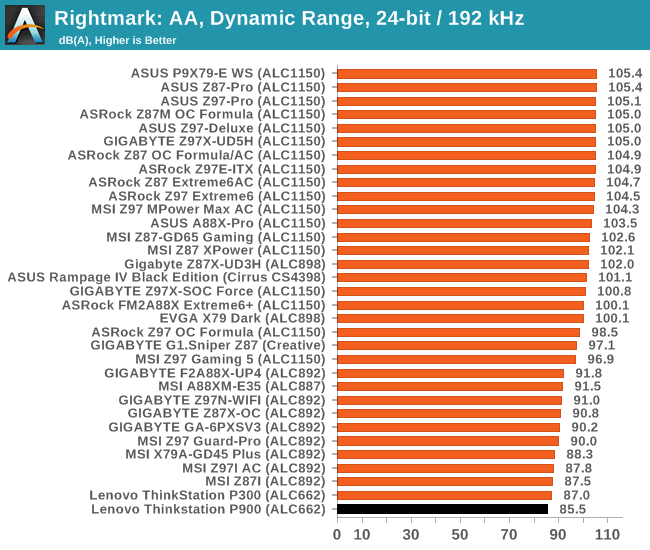
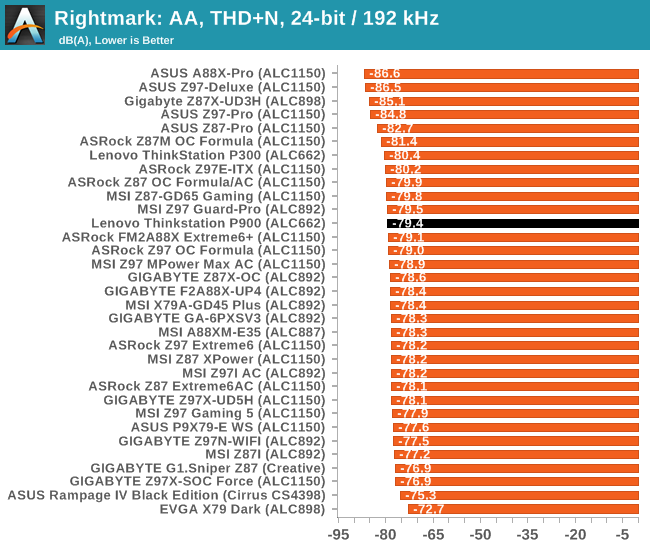
The ALC662 is a laptop audio codec at best, and as a result the P900 joins the P300 down at the bottom of our charts. The THD+N result is actually not that bad in retrospect.
USB Backup
For this benchmark, we transfer a set size of files from the SSD to the USB drive using DiskBench, which monitors the time taken to transfer. The files transferred are a 1.52 GB set of 2867 files across 320 folders – 95% of these files are small typical website files, and the rest (90% of the size) are small 30 second HD videos. In an update to pre-Z87 testing, we also run MaxCPU to load up one of the threads during the test which improves general performance up to 15% by causing all the internal pathways to run at full speed.
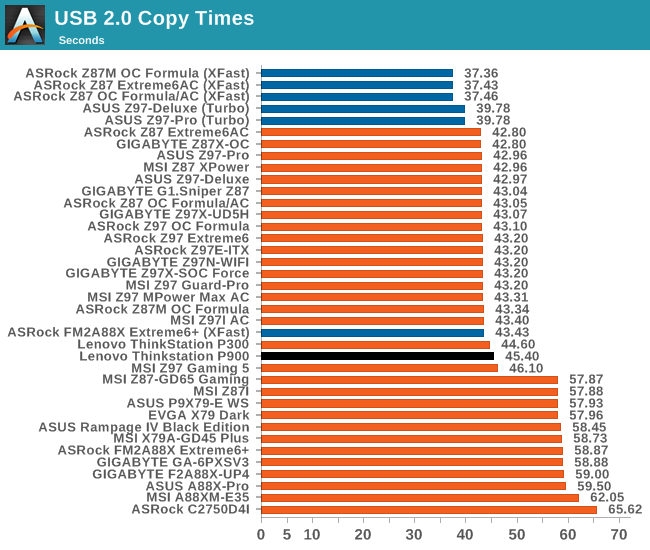
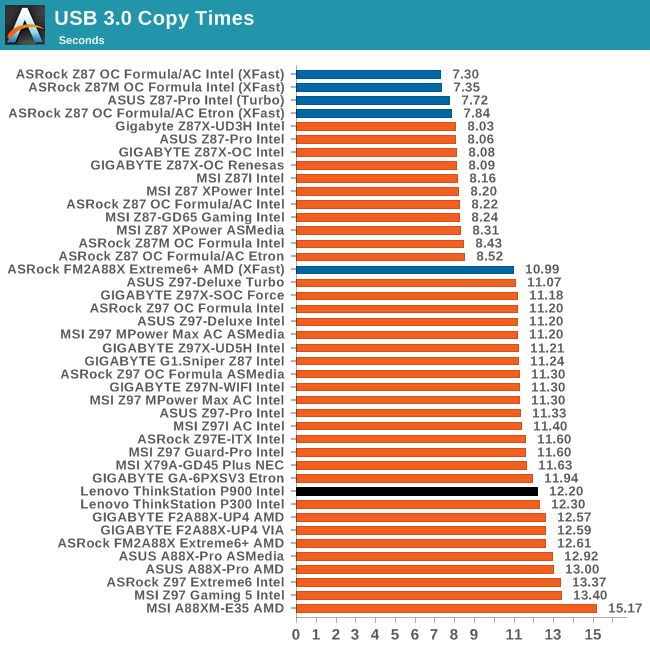
USB 2.0 perfromance follows that of our other 9-series testing, while USB 3.0 perfomance for the P900 is similar to the P300.
DPC Latency
Deferred Procedure Call latency is a way in which Windows handles interrupt servicing. In order to wait for a processor to acknowledge the request, the system will queue all interrupt requests by priority. Critical interrupts will be handled as soon as possible, whereas lesser priority requests such as audio will be further down the line. If the audio device requires data, it will have to wait until the request is processed before the buffer is filled.
If the device drivers of higher priority components in a system are poorly implemented, this can cause delays in request scheduling and process time. This can lead to an empty audio buffer and characteristic audible pauses, pops and clicks. The DPC latency checker measures how much time is taken processing DPCs from driver invocation. The lower the value will result in better audio transfer at smaller buffer sizes. Results are measured in microseconds.
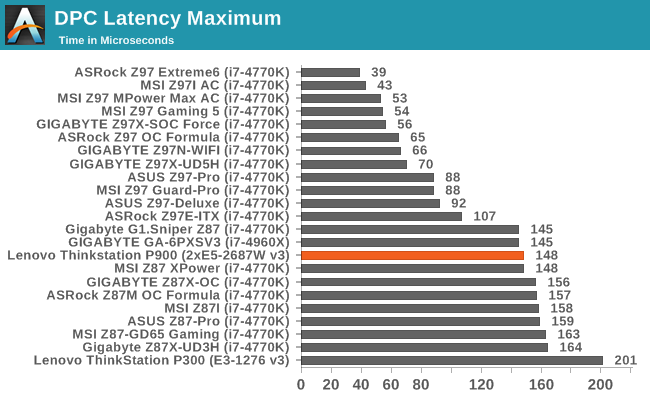
Normally 2P systems have horrendous DPC Latency numbers, but the P900 does rather well and matches some of our Z87 counterparts. Normally we prefer under 100 microseconds, but ultimately under 200 is a good result also.










61 Comments
View All Comments
Mikemk - Wednesday, May 6, 2015 - link
"these are the high TDP 160W models with 12 cores"Really? 12 cores?
mapesdhs - Wednesday, May 6, 2015 - link
Indeed, it should say 10, which is ironic as it's correctly described in the spec list that follows.My biggest complaint with systems like these is the lack of any backup drive of some kind for the C-drive; IMO this should be standard on all pro systems by now. I've helped with so many pro users over the years who've had normal rust spinners fail, at least with those there's usually a chance to rescue data before a drive completely dies, but with SSDs, normally no chance.
IBM could at least include a simple MX100 or something for C-drive backup.
Ian.
mapesdhs - Wednesday, May 6, 2015 - link
Also, which C-ray test are you using, with what parameters and how many threads? This matters a lot for comparing systems.mapesdhs - Wednesday, May 6, 2015 - link
Oops, stuck the above in the wrong place, sorry... still no post editing/deletion/etc. yet??dave_the_nerd - Wednesday, May 6, 2015 - link
IBM?MrSpadge - Wednesday, May 6, 2015 - link
IBM can't do anything about this system, it's Lenovo since many years by now.Samus - Wednesday, May 6, 2015 - link
It just goes to show how people still associate IBM with Lenovo's crap :\Let's face facts with facts...quality has declined since IBM turned over their PC division. Most Thinkpads are built to 'Ideapad' quality and engineering now, and in the case of the Thinkpad E, it IS an Ideapad. There isn't anything specifically "wrong" with Ideapads, but they don't live up to the Thinkpad reputation. None of the new Thinkpads do. Lenovo is also notorious for not standing behind their products, EOL'ing products quickly after a successor is released.
The last great Thinkpad's were the T4x/X40 series. Lenovo quickly ruined the T60 series with inadequate cooling for the discrete GPU's, leaving it up to the once-devoted Thinkpad community to create the utility TPfancontrol to fix the fan ramp-up issues. Issues persisted from there, with poor quality lithium cells and poor quality plastic ports ever since. Just Google T400/T500 USB ports cracking.
Long story short, on paper, the new Thinkstation P900 looks great on paper and initial review, but I'm sure issues will creep up that will not be adequately fixed. At least HP and Dell stand behind their products, especially their corporate-class products.
lophiomys - Wednesday, May 13, 2015 - link
FULL ACK to Samus regarding the poor quality of Lenovo Thinkpads and general lack of service by Lenovo. Still typing on a wonderful IBM Thinkpads T43p ...I like the design concept of the P900, but would only consider buying one at a - 50% rebate.
vision33r - Sunday, May 17, 2015 - link
Years ago, when Thinkpad turned over to Lenovo. I said it's gonna suck to my manager and he said it's a "Thinkpad" and he went ahead and purchased about 200 T60 thinkpads. Almost 1/2 of them went back and needed systemboard swaps. The drivers they issued were crap and resulted in lots of blue screens. Today, I don't work on laptops anymore and some poor support person was walking around swapping Thinkpad X1 Carbons. He said they are pretty flakey, a lot of them just crap out and they are brand spanking new. Hardware is great but reliability just not very good.PitneFor - Wednesday, May 6, 2015 - link
wut , backups should be done with backup software to some sort of redundant hard drive array . or plug a usb drive in if your that amateur